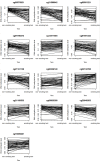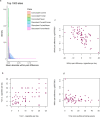Effects of smoking on genome-wide DNA methylation profiles: A study of discordant and concordant monozygotic twin pairs
- PMID: 37643467
- PMCID: PMC10501767
- DOI: 10.7554/eLife.83286
Effects of smoking on genome-wide DNA methylation profiles: A study of discordant and concordant monozygotic twin pairs
Abstract
Background: Smoking-associated DNA methylation levels identified through epigenome-wide association studies (EWASs) are generally ascribed to smoking-reactive mechanisms, but the contribution of a shared genetic predisposition to smoking and DNA methylation levels is typically not accounted for.
Methods: We exploited a strong within-family design, that is, the discordant monozygotic twin design, to study reactiveness of DNA methylation in blood cells to smoking and reversibility of methylation patterns upon quitting smoking. Illumina HumanMethylation450 BeadChip data were available for 769 monozygotic twin pairs (mean age = 36 years, range = 18-78, 70% female), including pairs discordant or concordant for current or former smoking.
Results: In pairs discordant for current smoking, 13 differentially methylated CpGs were found between current smoking twins and their genetically identical co-twin who never smoked. Top sites include multiple CpGs in CACNA1D and GNG12, which encode subunits of a calcium voltage-gated channel and G protein, respectively. These proteins interact with the nicotinic acetylcholine receptor, suggesting that methylation levels at these CpGs might be reactive to nicotine exposure. All 13 CpGs have been previously associated with smoking in unrelated individuals and data from monozygotic pairs discordant for former smoking indicated that methylation patterns are to a large extent reversible upon smoking cessation. We further showed that differences in smoking level exposure for monozygotic twins who are both current smokers but differ in the number of cigarettes they smoke are reflected in their DNA methylation profiles.
Conclusions: In conclusion, by analysing data from monozygotic twins, we robustly demonstrate that DNA methylation level in human blood cells is reactive to cigarette smoking.
Funding: We acknowledge funding from the National Institute on Drug Abuse grant DA049867, the Netherlands Organization for Scientific Research (NWO): Biobanking and Biomolecular Research Infrastructure (BBMRI-NL, NWO 184.033.111) and the BBRMI-NL-financed BIOS Consortium (NWO 184.021.007), NWO Large Scale infrastructures X-Omics (184.034.019), Genotype/phenotype database for behaviour genetic and genetic epidemiological studies (ZonMw Middelgroot 911-09-032); Netherlands Twin Registry Repository: researching the interplay between genome and environment (NWO-Groot 480-15-001/674); the Avera Institute, Sioux Falls (USA), and the National Institutes of Health (NIH R01 HD042157-01A1, MH081802, Grand Opportunity grants 1RC2 MH089951 and 1RC2 MH089995); epigenetic data were generated at the Human Genomics Facility (HuGe-F) at ErasmusMC Rotterdam. Cotinine assaying was sponsored by the Neuroscience Campus Amsterdam. DIB acknowledges the Royal Netherlands Academy of Science Professor Award (PAH/6635).
Keywords: DNA methylation; discordant twins; epidemiology; epigenetics; genetics; genomics; global health; human; identical twins; twin study.
Plain language summary
The genetic information of people who smoke present distinctive characteristics. In particular, previous research has revealed differences in patterns of DNA methylation, a type of chemical modification that helps cells switch certain genes on or off. However, most of these studies could not establish for sure whether these changes were caused by smoking, predisposed individuals to smoke, or were driven by underlying genetic variation in the DNA sequence itself. To investigate this question, van Dongen et al. examined DNA methylation data from the blood cells of over 700 pairs of identical twins. These individuals share the exact same genetic information, making it possible to better evaluate the impact of lifestyle on DNA modifications. The analyses identified differences in methylation at 13 DNA locations in pairs of twins where one was a current smoker and their sibling had never smoked. Two of the genes code for proteins involved in the response to nicotine, the primary addictive chemical in cigarette smoke. The differences were smaller if one of the twins had stopped smoking, suggesting that quitting can help to reverse some of these changes. These findings confirm that DNA methylation in blood cells is influenced by cigarette smoke, which could help to better understand smoking-associated diseases. They also demonstrate how useful identical twins studies can be to identify methylation changes that are markers of lifestyle.
© 2023, van Dongen et al.
Conflict of interest statement
Jv, GW, Ed, DB, MN No competing interests declared
Figures





Update of
- doi: 10.1101/2022.08.17.504357
Similar articles
-
Genome-wide association study meta-analysis of dizygotic twinning illuminates genetic regulation of female fecundity.Hum Reprod. 2024 Jan 5;39(1):240-257. doi: 10.1093/humrep/dead247. Hum Reprod. 2024. PMID: 38052102 Free PMC article.
-
Male microchimerism in females: a quantitative study of twin pedigrees to investigate mechanisms.Hum Reprod. 2021 Aug 18;36(9):2529-2537. doi: 10.1093/humrep/deab170. Hum Reprod. 2021. PMID: 34293108 Free PMC article.
-
Integrative DNA methylome analysis of pan-cancer biomarkers in cancer discordant monozygotic twin-pairs.Clin Epigenetics. 2016 Jan 20;8:7. doi: 10.1186/s13148-016-0172-y. eCollection 2016. Clin Epigenetics. 2016. PMID: 26798410 Free PMC article.
-
Solving the twin paradox-forensic strategies to identify the identical twins.Forensic Sci Int. 2024 Oct;363:112205. doi: 10.1016/j.forsciint.2024.112205. Epub 2024 Aug 29. Forensic Sci Int. 2024. PMID: 39213915 Review.
-
DNA methylation in monozygotic twins discordant for acute lymphoblastic leukemia: a case report and systematic review.Clin Epigenetics. 2025 Jun 6;17(1):94. doi: 10.1186/s13148-025-01906-z. Clin Epigenetics. 2025. PMID: 40481591 Free PMC article. Review.
Cited by
-
Intergenerational transmission of complex traits and the offspring methylome.Mol Psychiatry. 2025 Jul;30(7):3338-3347. doi: 10.1038/s41380-025-02981-7. Epub 2025 Apr 3. Mol Psychiatry. 2025. PMID: 40181191 Free PMC article.
-
Brain Neurotrophins and Plant Polyphenols: A Powerful Connection.Molecules. 2025 Jun 19;30(12):2657. doi: 10.3390/molecules30122657. Molecules. 2025. PMID: 40572619 Free PMC article. Review.
-
Unidirectional and Bidirectional Causation between Smoking and Blood DNA Methylation: Evidence from Twin-based Mendelian Randomisation.medRxiv [Preprint]. 2024 Nov 22:2024.06.19.24309184. doi: 10.1101/2024.06.19.24309184. medRxiv. 2024. Update in: Eur J Epidemiol. 2025 Jan;40(1):55-69. doi: 10.1007/s10654-024-01187-5. PMID: 38946972 Free PMC article. Updated. Preprint.
-
Lifestyle differences between co-twins are associated with decreased similarity in their internal and external exposome profiles.Sci Rep. 2024 Sep 11;14(1):21261. doi: 10.1038/s41598-024-72354-7. Sci Rep. 2024. PMID: 39261679 Free PMC article.
-
Quantifying the stochastic component of epigenetic aging.Nat Aging. 2024 Jun;4(6):886-901. doi: 10.1038/s43587-024-00600-8. Epub 2024 May 9. Nat Aging. 2024. PMID: 38724732 Free PMC article.
References
Publication types
MeSH terms
Grants and funding
LinkOut - more resources
Full Text Sources

